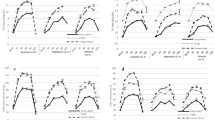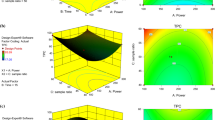Abstract
The main aim of this study was to evaluate pressurized hot water as a green and environmentally friendly extraction medium for the isolation of phenolic compounds from larch waste wood. Such isolates could find applications in the food, feed, pharmaceutical and cosmetics industries or as natural ingredients for adhesives or biocidal coatings in the wood industry. In the first step different larch wood fractions were extracted using batch system aiming to determine the most suitable fraction for isolation. The content of extractives, total phenolic and tannin content of obtained extracts and their antioxidant activity were evaluated. Secondly, semi-continuous operation was applied, where effects of temperature, addition of ethanol and flow rate were studied. Extraction yield was monitored and extracts were again analyzed for their total phenolic content and antioxidant activity. HPLC analysis was performed, in order to study the effect of temperature and addition of ethanol on the hydrothermal degradation of phenolics during semi-continuous operation. Finally, the economics of pilot-scale and industrial-scale processes with different extractor capacities, ranging from approximately 12 to 1200 kg of woody material per day and operating at optimal conditions for isolation of larch wood extractives was evaluated, in order to determine the cost of manufacturing of such a product.
Graphical Abstract








Similar content being viewed by others
References
Abdelmoez W, Yoshida H (2006) Simulation of fast reactions in batch reactors under sub-critical water condition. AIChE J 52:3600–3611. doi:10.1002/aic.10970
Asghari FS, Yoshida H (2010) Conversion of Japanese red pine wood (Pinus densiflora) into valuable chemicals under subcritical water conditions. Carbohydr Res 345:124–131. doi:10.1016/j.carres.2009.10.006
Babkin VA, Malkov YA, Medvedeva EN, Trofimova NN, Ivanova NV (2012) An eco-friendly technology for polysaccharide production from logging and sawing waste. Russ J Gen Chem 82:955–962. doi:10.1134/S1070363212050283
Bermejo MD, Cocero MJ (2006) Supercritical water oxidation: a technical review. AIChE J 52:3933–3951. doi:10.1002/aic.10993
Buchner N, Krumbein A, Rohn S, Kroh LW (2006) Effect of thermal processing on the flavonols rutin and quercetin. Rapid Commun Mass Spectrom 20:3229–3235. doi:10.1002/rcm.2720
Chalupa V (1991) Larch (Larix decidua Mill.). In: Bajaj YPS (ed) Trees III, vol 16. Spinger, Berlin, Heidelberg, pp 446–468
Clifford AA (2008) Change of water properties with temperature. Critical Processes. http://www.criticalprocesses.com/Use%20of%20enthalpies%20to%20calculate%20energy%20needed.htm. Accessed on 6 Sept 2014
Demenkova LI, Ivanova EE, Shmidt ÉN (1993) Extractive substances of the bark of Larix sibirica growing in the Altai. Chem Nat Compd 29:679–680. doi:10.1007/BF00630226
Feng S, Cheng S, Yuan Z, Leitch M, Xu C (2013) Valorization of bark for chemicals and materials: a review. Renew Sust Energy Rev 26:560–578. doi:10.1016/j.rser.2013.06.024
Gierlinger N, Jacques D, Schwanninger M, Wimmer R, Pâques L (2004) Heartwood extractives and lignin content of different larch species (Larix sp.) and relationships to brown-rot decay-resistance. Trees 18:230–236. doi:10.1007/s00468-003-0300-0
Hartonen K, Parshintsev J, Sandberg K, Bergelin E, Nisula L, Riekkola ML (2007) Isolation of flavonoids from aspen knotwood by pressurized hot water extraction and comparison with other extraction techniques. Talanta 74:32–38. doi:10.1016/j.talanta.2007.05.040
Ivanova SZ, Gorshkov AG, Kuzmin AV, Gordienko II, Babkin VA (2012) Phenolic compounds of Siberian and Dahurian larch phloem Russ J. Bioorg Chem 38:769–774. doi:10.1134/S1068162012070096
Kulkarni YA, Gokhale SB, Yele SU, Surana SJ, Tatiya AU (2011) Pharmacognostical studies and preliminary phytochemical investigations on the bark of Persea macrantha (Nees) Kosterm (Lauraceae) Ind J. Nat Prod Res 2:211–217
Laireiter CM, Schnabel T, Köck A, Stalzer P, Petutschnigg A, Oostingh GJ, Hell M (2013) Active anti-microbial effects of larch and pine wood on four bacterial strains. Bioresources 9:273–281
Ma C, Yang L, Wang W, Yang F, Zhao C, Zu Y (2012) Extraction of dihydroquercetin from Larix gmelinii with ultrasound-assisted and microwave-assisted alternant digestion. Int J Mol Sci 13:8789–8804. doi:10.3390/ijms13078789
Majhenič L, Škerget M, Knez Ž (2007) Antioxidant and antimicrobial activity of guarana seed extracts. Food Chem 104:1258–1268. doi:10.1016/j.foodchem.2007.01.074
Niazi A, Dai JS, Balabani S, Seneviratne L (2005) Product cost estimation: technique classification and methodology review. J Manuf Sci Eng 128:563–575. doi:10.1115/1.2137750
Ostroukhova LA, Raldugin VA, Babkin VA, Onuchina NA, Levchuk AA (2012) Investigation of the chemical composition of larch wood resin Russ J. Bioorg Chem 38:775–779. doi:10.1134/S1068162012070151
Pavlovič I, Knez Ž, Škerget M (2013) Hydrothermal reactions of agricultural and food processing wastes in sub- and supercritical water: a review of fundamentals, mechanisms, and state of research. J Agric Food Chem 61:8003–8025. doi:10.1021/jf401008a
Petridis GK (2011) Tannins: types, foods containing, and nutrition. Food Science and Technology, Nova Science Publishers, Hauppauge
Pferschy-Wenzig EM, Kunert O, Presser A, Bauer R (2008) In vitro anti-inflammatory activity of larch (Larix decidua L.) sawdust. J Agric Food Chem 56:11688–11693. doi:10.1021/jf8024002
Ravber M, Knez Ž, Škerget M (2015) Simultaneous extraction of oil- and water-soluble phase from sunflower seeds with subcritical water. Food Chem 166:316–323. doi:10.1016/j.foodchem.2014.06.025
Romero C (2012) http://www.ecology.info/bark-ecology.htm. Accessed on 7 Oct 2014
Rowe JW (1989) Natural products of woody plants: chemicals extraneous to the lignocellulosic cell wall, vol 1. Springer, Berlin
Seider WD, Seader JD, Lewin DR (2009) Product and process design principles: synthesis, analysis and evaluation. Wiley United States of America Pvt. Limited, Hoboken
Teo CC, Tan SN, Yong JW, Hew CS, Ong ES (2010) Pressurized hot water extraction (PHWE). J Chromatogr A 1217:2484–2494. doi:10.1016/j.chroma.2009.12.050
Veggi PC, Cavalcanti RN, Meireles MAA (2014) Production of phenolic-rich extracts from Brazilian plants using supercritical and subcritical fluid extraction: experimental data and economic evaluation. J Food Eng 131:96–109. doi:10.1016/j.jfoodeng.2014.01.027
Wen-jie W, Xue-ying L, Yuan-gang Z (2005) Dynamic feature of flavonoids content in different organs of larch (Larix gmelinii). J For Res 16:89–92. doi:10.1007/BF02857896
Willfőr SM et al (2003) Antioxidant activity of knotwood extractives and phenolic compounds of selected tree species. J Agric Food Chem 51:7600–7606. doi:10.1021/jf030445h
Zule J, Kozjan G (2008) Polifenoli v različnih vrstah macesna (Larix spp.) = Polyphenols in different larch (Larix spp.) species. Zb gozd lesar 86:51–58
Acknowledgments
Authors are grateful to the Slovenian Ministry of High Education, Science and Technology for the financial support of this work. This paper was produced within the framework of the operation entitled “Centre of Open innovation and ResEarch of University of Maribor (CORE@UM)”.
Author information
Authors and Affiliations
Corresponding author
Electronic supplementary material
Below is the link to the electronic supplementary material.
Rights and permissions
About this article
Cite this article
Ravber, M., Knez, Ž. & Škerget, M. Isolation of phenolic compounds from larch wood waste using pressurized hot water: extraction, analysis and economic evaluation. Cellulose 22, 3359–3375 (2015). https://doi.org/10.1007/s10570-015-0719-7
Received:
Accepted:
Published:
Issue Date:
DOI: https://doi.org/10.1007/s10570-015-0719-7




